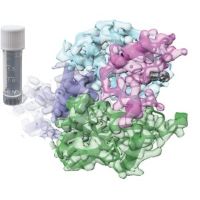Specification
| Description | Recombinant protein from the full-length sequence of Homo sapiens CD96 molecule (CD96), transcript variant 1 (NM_198196). |
| Organism | Homo sapiens (Human) |
| Expression Host | Human Cells |
| Tag Info | His or DYKDDDDK. Please contact us if you need further information or require specific designed tag. |
| Purity | Greater than 90% by SDS-PAGE gel |
| Uniprot ID | P40200 |
| Entry Name | TACT_HUMAN |
| Gene Names | CD96 |
| Alternative Gene Names | |
| Alternative Protein Names | T-cell surface protein tactile (Cell surface antigen CD96) (T cell-activated increased late expression protein) (CD antigen CD96) |
| Application | Antigens, Western, ELISA and other in vitro binding or in vivo functional assays, and protein-protein interaction studies; For research & development use only! |
| Buffer | Purified protein formulated in a sterile solution of PBS buffer, pH7.2, without any preservatives |
| Endotoxin | Endotoxin level is < 0.1 ng/µg of protein (<1EU /µg) |
| Length | 585 |
| Molecular Weight(Da) | 65634 |
| Protein Sequence | (The sequence of expressed protein may have some variation from the sequence shown below. Please contact us for the exact sequence.) MEKKWKYCAVYYIIQIHFVKGVWEKTVNTEENVYATLGSDVNLTCQTQTVGFFVQMQWSKVTNKIDLIAVYHPQYGFYCAYGRPCESLVTFTETPENGSKWTLHLRNMSCSVSGRYECMLVLYPEGIQTKIYNLLIQTHVTADEWNSNHTIEIEINQTLEIPCFQNSSSKISSEFTYAWSVENSSTDSWVLLSKGIKEDNGTQETLISQNHLISNSTLLKDRVKLGTDYRLHLSPVQIFDDGRKFSCHIRVGPNKILRSSTTVKVFAKPEIPVIVENNSTDVLVERRFTCLLKNVFPKANITWFIDGSFLHDEKEGIYITNEERKGKDGFLELKSVLTRVHSNKPAQSDNLTIWCMALSPVPGNKVWNISSEKITFLLGSEISSTDPPLSVTESTLDTQPSPASSVSPARYPATSSVTLVDVSALRPNTTPQPSNSSMTTRGFNYPWTSSGTDTKKSVSRIPSETYSSSPSGAGSTLHDNVFTSTARAFSEVPTTANGSTKTNHVHITGIVVNKPKDGMSWPVIVAALLFCCMILFGLGVRKWCQYQKEIMERPPPFKPPPPPIKYTCIQEPNESDLPYHEMETL |
Background
| Function | FUNCTION: May be involved in adhesive interactions of activated T and NK cells during the late phase of the immune response. Promotes NK cell-target adhesion by interacting with PVR present on target cells. May function at a time after T and NK cells have penetrated the endothelium using integrins and selectins, when they are actively engaging diseased cells and moving within areas of inflammation. |
| Pathway | |
| Protein Families | |
| Tissue Specificity |
QC Data
| Note | Please contact us for QC Data |
| Product Image (Reference Only) |  |

